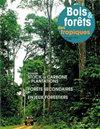Effects of soil biotic and abiotic properties on the growth and mycorrhization of Cedrus atlantica Manetti cedars
IF 0.6
4区 农林科学
Q3 FORESTRY
引用次数: 1
Abstract
Cedrus atlantica Manetti is an emblematic species of great ecological, economic and social value. However, its weak root architecture seriously compromises (re)afforestation and regeneration of the species. Although it is known that mycorrhization is beneficial to cedars growing in unfavourable conditions, our knowledge on the mycorrhization of cedar seedlings is remains patchy. These difficulties show a need to study the interactions between the roots and the soil biotic and abiotic factors and to seek solutions to promote the mycorrhization of cedar seedlings. For this purpose, we studied the responses of cedar seedlings to the physico-chemical, textural, hydromechanical and microbiological factors of the soil and mycorrhization success in juvenile cedars. The response of C. atlantica seedlings to the textural and physico-chemical properties of soils in cedar woods shows that they are highly dependent on organic carbon, nitrogen and phosphorus contents and on the soil's granulometry. These factors stimulate the growth of secondary roots in some soils while in others, they cause seedling growth to predominate. The provenances of C. atlantica show a high nitrogen requirement and different preferences for nitrogen forms. Variations in the cotyledons also reveal different patterns of adaptation to nitrogen nutrition. The hydromechanical properties of the culture medium profoundly affect C. atlantica seedlings, so that in extreme cases, they either over-stimulate the elongation of unbranched main roots or completely inhibit their elongation, producing a great many reduced lateral roots. On the anatomical scale, these responses are more apparent around the cortex. Interactions with the native soil microflora have a determining effect on the growth of C. atlantica seedlings, since the microbial composition of the soil can stimulate growth and decrease the density of roots. The nutrient depletion of 6 soils allowed the trapping of 15 species of ectomycorrhizal fungi of young C. atlantica seedlings. This indicates the crucial importance of this new range of mycorrhizal fungi, characterized for the first time in C. atlantica seedlings, especially for work aiming to improve the health status of cedar seedlings.土壤生物和非生物特性对大西洋杉生长和菌根化的影响
大西洋杉是一种具有巨大生态、经济和社会价值的标志性物种。然而,其薄弱的根系结构严重影响了该物种的(再)造林和更新。虽然已知菌根化有利于雪松在不利条件下生长,但我们对雪松幼苗菌根化的了解仍然是不完整的。这些困难表明需要研究根系与土壤生物和非生物因素之间的相互作用,并寻求促进雪松幼苗菌根化的解决方案。为此,我们研究了雪松幼苗对土壤理化、质地、水力学和微生物等因素的响应以及幼雪松菌根成功的情况。大西洋杉木幼苗对杉木林地土壤结构和理化性质的响应表明,大西洋杉木幼苗高度依赖于有机碳、氮、磷含量和土壤粒度。这些因素在一些土壤中刺激次生根的生长,而在另一些土壤中,它们使幼苗生长占优势。各种源对氮的需要量高,对氮形态的偏好不同。子叶的变异也揭示了对氮营养的不同适应模式。培养基的水力学特性对大西洋青霉幼苗影响深远,在极端情况下,要么过度刺激未分枝主根的伸长,要么完全抑制主根的伸长,产生大量减少的侧根。在解剖学层面上,这些反应在皮层周围更为明显。土壤微生物的组成可以促进大西洋蓝幼苗的生长,降低根系密度,因此与本地土壤微生物区系的相互作用对大西洋蓝幼苗的生长具有决定性作用。6种土壤的养分枯竭使大西洋青木幼苗的15种外生菌根真菌被捕获。这表明了这一新的菌根真菌系列的重要性,这是首次在大西洋杉幼苗中发现的,特别是对改善雪松幼苗健康状况的工作至关重要。
本文章由计算机程序翻译,如有差异,请以英文原文为准。
求助全文
约1分钟内获得全文
求助全文
来源期刊

Bois et Forets Des Tropiques
FORESTRY-
CiteScore
1.50
自引率
16.70%
发文量
31
审稿时长
>12 weeks
期刊介绍:
In 1947, the former Tropical Forest Technical Centre (CTFT), now part of CIRAD, created the journal Bois et Forêts des Tropiques. Since then, it has disseminated knowledge and research results on forests in intertropical and Mediterranean regions to more than sixty countries. The articles, peer evaluated and reviewed, are short, synthetic and accessible to researchers, engineers, technicians, students and decision-makers. They present original, innovative research results, inventions or discoveries. The journal publishes in an international dimension. The topics covered are of general interest and are aimed at an informed international audience.
 求助内容:
求助内容: 应助结果提醒方式:
应助结果提醒方式:


